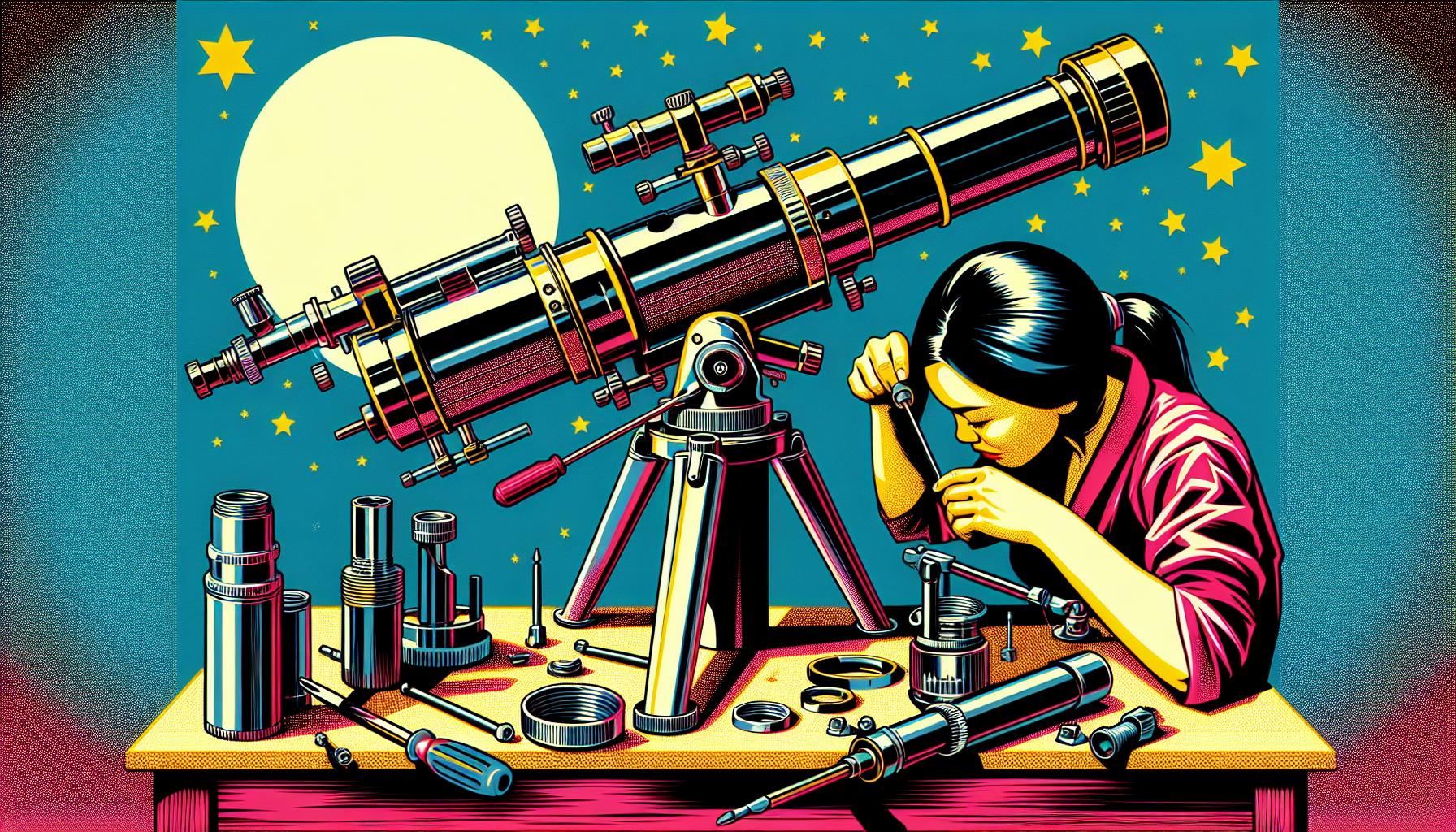This site contains affiliate links to products. I may receive a commission for purchases made through these links.
Ever looked up at the night sky and wished you could see those distant celestial bodies up close? Well, I’ve got good news. You don’t need to break the bank buying a high-end telescope. You can make your own! And the heart of any good telescope? The lens.
In this article, I’ll guide you through the process of making a lens for a telescope. It’s not as complicated as you might think. With a bit of patience and the right materials, you’ll be stargazing in no time. So, let’s dive into the fascinating world of lens making.
Choosing the Right Materials
So, you’re curious to dive deeper into the intriguing world of lens making? Great! Before we advance further, it’s crucial to select the right materials – they’ll act as the foundation of our lens creation process.
The first step in our lens making quest involves choosing the right glass. The type of glass you need depends on the kind of telescope you want. For a refractor telescope, you’ll need crown and flint glass. These two types of glass bend light at different rates, delivering a sharp, clear image.
Let’s have a look at a comparison of these two types of glass:
| Glass Type | Light Bending Ratio |
|---|---|
| Crown | Low |
| Flint | High |
Now moving on to the shaping tools. Grinding and polishing the glass into a lens shape is a task that requires precision and patience. You’ll need grit and polishing compound, which can be picked up at any hobby store or online. Another highly important tool to mention is a pitch lap – used for that final polishing stage.
Ultimately, the correct selection of materials can significantly enhance the quality of your homemade telescope lens. Keep in mind to handle all materials with utmost care – remember, making a lens involves not just patience and precision, but also safety.
In the following sections, we’ll delve more deeply into each of these materials and direct you on how to manipulate them to make your telescope lens. From choosing the right type of glass to the final stages of polishing, we’ll be right by your side through this fascinating journey of lens making. Keep your excitement fueled and stay with us for the next steps.
Understanding the Basics of Optics
Diving deeper, it’s essential I understand the basics of optics. This knowledge gives me a firm foundation that’s crucial for lens making. So, what is optics? Optics is the branch of physics that studies light and the way it interacts with matter. It also investigates the properties of light and how it can be harnessed and manipulated for various purposes, including lenses for telescopes.
One of the main elements of optics that I need to understand is refraction. This phenomenon, when light passes from one medium to another and changes direction, is the foundational principle behind all refracting telescopes. There are two primary types of refraction.
- Single refraction, which is when light enters a medium at an angle and bends in one direction.
- Double refraction, also known as birefringence, occurs when a wave divides into two separate waves, with each wave refracting differently.
The materials used in making a lens, including the crown and flint glass mentioned earlier, play a major role in this refraction process. Each type of glass has distinct dispersive properties, resulting in different bending degrees of light known as the refractive index. The refractive index is the speed of light in a vacuum divided by the speed of light in the medium.
The refractive index is a property that defines the lens’s shape and, by extension, the telescope’s performance. Its manipulation lets me control the direction and focus of light, an aspect fundamental to our purpose.
The path to gaining these skills is by repeatedly testing, reshaping, and perfecting my lenses.
As I journey on adopting the telescope lens making process, I’ll continue to share more specifics on how to shape and refine the lens, the right tools to use, and the meticulousness required for the task.
Grinding and Polishing the Lens
Right after choosing the right materials and completing an analysis of the refractive index, we are now ready to move on to shaping and refining the lens. This process involves two primary tasks: grinding and polishing.
Grinding is where the actual shaping of the lens begins. It’s a process that involves removing material from the lens blank to achieve the desired curvature. The grinding wheel, often diamond edged, is used for this process. You must ensure the lens maintains a uniform thickness, thus providing a highly controlled and predictable rate of material removal.
However, it’s essential to note that perfecting lens grinding is not an overnight process. Practice and patience are key elements to mastering this technique, and obtaining an ideal lens curvature can take several attempts.
Following grinding, the next phase is polishing. This stage is all about refining the lens’s surface and removing the minuscule imperfections left by the grinding process. Using a mix of ultra-fine abrasives and some form of lubricant, we can transform the rough lens surface into a smooth one. The smoother and cleaner the lens surface, the better the light transmission which results in better image resolution.
To put numbers into perspective, let’s look at a brief comparison.
| Stage | Material Removal | Surface Roughness |
|---|---|---|
| Grinding | High | High |
| Polishing | Low | Low |
Clearly, grinding and polishing go hand in hand. They allow us to minimize imperfections and enhance the lens’s overall performance. These stages require meticulous attention to detail and contribute significantly to the final optical property of our telescope lens.
However, remember that making a telescope lens is a beautiful blend of science, craftsmanship, and patience. And as we progress towards creating the ultimate viewing instrument, let’s delve deeper into another crucial aspect – lens testing.
Testing and Fine-tuning the Lens
Transitions from lens-grinding and polishing stages flow naturally into the realm of testing and fine-tuning. These are pivotal steps in our journey to creating a fine-tuned telescope lens.
Testing the lens let’s us gauge its optical property and identify any potential issues. This stage involves several procedures. Let’s break these down into easily digestible points:
- Spherical aberration test: This checks for deviations in the lens’s curvature. A well-ground lens should focus light rays to a single point. If it doesn’t, that implies the lens’s shape needs correction.
- Chromatic aberration test: Determines if the lens separates light into different colors. If it does, more work is required to reduce such color separation.
- Polishing imperfection test: This checks the quality of your polishing job. A lens with poor polish might cause scattered light, thus requiring further polishing.
The process of fine-tuning, on the other hand, is where we rectify identified errors through minor grinding, and potentially, more polishing. Each modification has to be followed by another round of testing to ensure its efficacy.
Through thorough testing and meticulous fine-tuning, I am able to gradually refine the lens to near-perfection. But let’s not forget – this demands a great deal of patience. It’s not uncommon for this iterative process to take up several hours, or even days. For me, it is certainly worth the wait.
By observing proper lens-making protocols and employing a methodical approach, we can enhance our lens’s quality. These rigorous practices contribute significantly to the final optical property of the telescope lens, defining the clarity and quality of our stargazing experience.
My journey into the intricate world of lens making continues. From grinding to polishing, testing to fine-tuning, every step brings me closer to that perfect view of the cosmos. I look forward to sharing more insights as I delve deeper into the nuts and bolts of making a telescope lens.
Assembling the Telescope
After crafting the perfect lens, we’re ready for the next crucial phase: assembling the telescope. As with the lens-making process, precision and patience are key in telescope assembly. Initiate the process by first gathering all the necessary components.
Here’s the checklist:
- The main telescope tube
- Focuser
- Mirror or lens cell
- Eyepiece holder
- Finder scope
The main telescope tube forms the body of our instrument. It should be lightweight yet robust enough to hold all the components together. Aluminium is a common choice for this part due to its strength and lightweight nature.
Up next, we deal with the focuser. This mechanism allows adjustment of the view by moving the eyepiece nearer or farther from the primary lens or mirror. There are two main types: Crayford and rack-and-pinion.
The mirror or lens cell, which holds the mirror or lens, demands careful handling. It’s essential not to exert excessive pressure and alter the mirror or lens shape. Our painstakingly crafted lens would take this position gloriously.
Don’t forget the eyepiece holder, another critical component. It enables swapping of different eyepieces to modify magnification, field of view and eye relief.
The finder scope is like the guide to astronomers. Mounted on the telescope’s main body, it provides a larger field of view to easily spot celestial bodies.
Every piece in place, following a methodical approach ensures everything fits together seamlessly. Yet, the journey doesn’t end here. Every well-assembled telescope still requires an alignment process known as collimation, essential to delivering sharp images. This telescope and its home-crafted lens hold a promise of many stunning star-lit nights.
Conclusion
So there you have it. I’ve guided you through the intricate process of making a telescope lens and assembling your own telescope. It’s clear that precision and patience are key to this endeavor.
Remember, each component – the main tube, focuser, lens cell, eyepiece holder, and finder scope – plays a vital role in your telescope’s performance. And don’t forget the importance of collimation to secure sharp images. With your home-crafted lens and well-assembled telescope, you’re all set for countless starlit nights of exploration. The universe is waiting for you. Happy stargazing!
Don’t forget to subscribe to our newsletter where you’ll find the latest cosmic discoveries, expert stargazing tips, and exclusive subscriber deals. Embark on your cosmic journey if you haven’t already!
FAQ
What components are involved in the telescope assembly?
The necessary components for assembling a telescope include the main telescope tube, focuser, mirror or lens cell, eyepiece holder, and finder scope. Each plays a crucial role in the successful functionality of the telescope.
What does each component of the telescope do?
Each component serves a distinct purpose. The main telescope tube houses the telescope’s optics. The focuser connects the eyepiece to the telescope and allows for fine adjustments. The mirror or lens cell holds the telescope’s primary mirror or lens. The eyepiece holder secures the eyepiece, and the finder scope helps you aim the telescope.
Why is collimation essential in telescope assembly?
Collimation is the alignment process that ensures sharp images. The article mentions it as a key step in telescope assembly to guarantee quality observations and forecasts many star-lit nights with a well-assembled telescope and home-crafted lens.




